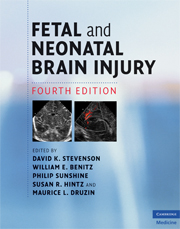Book contents
- Frontmatter
- Contents
- List of contributors
- Foreword
- Preface
- Section 1 Epidemiology, pathophysiology, and pathogenesis of fetal and neonatal brain injury
- Section 2 Pregnancy, labor, and delivery complications causing brain injury
- Section 3 Diagnosis of the infant with brain injury
- Section 4 Specific conditions associated with fetal and neonatal brain injury
- 22 Congenital malformations of the brain
- 23 Neurogenetic disorders of the brain
- 24 Hemorrhagic lesions of the central nervous system
- 25 Neonatal stroke
- 26 Hypoglycemia in the neonate
- 27 Hyperbilirubinemia and kernicterus
- 28 Polycythemia and fetal–maternal bleeding
- 29 Hydrops fetalis
- 30 Bacterial sepsis in the neonate
- 31 Neonatal bacterial meningitis
- 32 Neurological sequelae of congenital perinatal infection
- 33 Perinatal human immunodeficiency virus infection
- 34 Inborn errors of metabolism with features of hypoxic–ischemic encephalopathy
- 35 Acidosis and alkalosis
- 36 Meconium staining and the meconium aspiration syndrome
- 37 Persistent pulmonary hypertension of the newborn
- 38 Pediatric cardiac surgery: relevance to fetal and neonatal brain injury
- Section 5 Management of the depressed or neurologically dysfunctional neonate
- Section 6 Assessing outcome of the brain-injured infant
- Index
- Plate section
- References
36 - Meconium staining and the meconium aspiration syndrome
from Section 4 - Specific conditions associated with fetal and neonatal brain injury
Published online by Cambridge University Press: 12 January 2010
- Frontmatter
- Contents
- List of contributors
- Foreword
- Preface
- Section 1 Epidemiology, pathophysiology, and pathogenesis of fetal and neonatal brain injury
- Section 2 Pregnancy, labor, and delivery complications causing brain injury
- Section 3 Diagnosis of the infant with brain injury
- Section 4 Specific conditions associated with fetal and neonatal brain injury
- 22 Congenital malformations of the brain
- 23 Neurogenetic disorders of the brain
- 24 Hemorrhagic lesions of the central nervous system
- 25 Neonatal stroke
- 26 Hypoglycemia in the neonate
- 27 Hyperbilirubinemia and kernicterus
- 28 Polycythemia and fetal–maternal bleeding
- 29 Hydrops fetalis
- 30 Bacterial sepsis in the neonate
- 31 Neonatal bacterial meningitis
- 32 Neurological sequelae of congenital perinatal infection
- 33 Perinatal human immunodeficiency virus infection
- 34 Inborn errors of metabolism with features of hypoxic–ischemic encephalopathy
- 35 Acidosis and alkalosis
- 36 Meconium staining and the meconium aspiration syndrome
- 37 Persistent pulmonary hypertension of the newborn
- 38 Pediatric cardiac surgery: relevance to fetal and neonatal brain injury
- Section 5 Management of the depressed or neurologically dysfunctional neonate
- Section 6 Assessing outcome of the brain-injured infant
- Index
- Plate section
- References
Summary
Introduction
Meconium-stained amniotic fluid (MSAF) occurs in approximately 10–15% of all pregnancies. The presence of MSAF has been recognized as being associated with adverse fetal and neonatal outcomes for centuries. Aristotle gave the substance the name meconium-arion, meaning “opium-like.” This may have been because the philosopher believed it induced fetal sleep, recognizing fetal deaths and neonatal depression as being associated with meconium. Conversely, the name may have arisen because processed opium is a black, tarry substance resembling meconium. Obstetricians and pediatricians have long recognized the relationship of MSAF with stillborn infants, abnormal fetal heart-rate (FHR) tracings, neonatal encephalopathy, respiratory distress, and an abnormal neurologic outcome in some survivors. Nevertheless, the vast majority of infants born through MSAF do not have apparent antenatal, intrapartum, or postnatal problems. Thus we have somewhat limited ability to predict and prognosticate from the presence of MSAF. Healthcare providers should be appropriately concerned about both MSAF and meconium-stained neonates who subsequently develop respiratory distress, the meconium aspiration syndrome (MAS). Despite the frequent occurrence of MSAF and MAS, there remains a distinct paucity of literature describing the neurological development of either children born through MSAF or those with MAS.
- Type
- Chapter
- Information
- Fetal and Neonatal Brain Injury , pp. 409 - 418Publisher: Cambridge University PressPrint publication year: 2009



